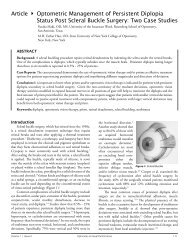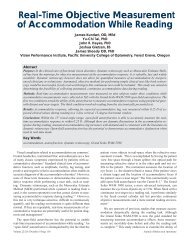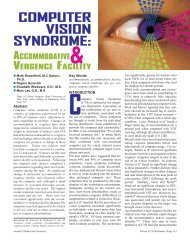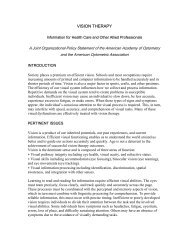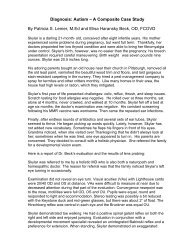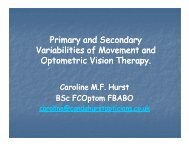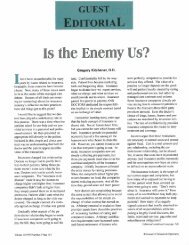You also want an ePaper? Increase the reach of your titles
YUMPU automatically turns print PDFs into web optimized ePapers that Google loves.
<strong>Us<strong>in</strong>g</strong> <strong>the</strong> <strong>Balance</strong> <strong>Board</strong> <strong>in</strong> <strong>Therapy</strong><br />
Practical applications for l<strong>in</strong>k<strong>in</strong>g somato-sensory and vestibular<br />
systems to <strong>the</strong> collaboration between <strong>the</strong> eyes and bra<strong>in</strong>.<br />
Vision <strong>Therapy</strong> establishes and supports visual function that will<br />
rema<strong>in</strong> stable and comfortable under a variety of conditions. Ideally,<br />
this function should be l<strong>in</strong>ked to comfortably stable posture, balance,<br />
and whole body function.<br />
Patients are supervised dur<strong>in</strong>g Vision <strong>Therapy</strong> to ensure that proper<br />
visual-motor responses are embedded. When add<strong>in</strong>g a balance<br />
board or o<strong>the</strong>r labile surface to a vision <strong>the</strong>rapy program, care must<br />
be taken to ensure that efficient global motor patterns are embedded<br />
with visual function.<br />
<strong>Balance</strong> board application <strong>in</strong>volves “active” care, designed to retra<strong>in</strong><br />
motor patterns and neurological l<strong>in</strong>ks.<br />
The goals <strong>in</strong>clude embedd<strong>in</strong>g ideal cortical motor programs as well<br />
as stabiliz<strong>in</strong>g local dysfunction.<br />
The application of balance <strong>the</strong>rapy utilizes <strong>the</strong> <strong>in</strong>terrelationship<br />
between end sensory organs, <strong>the</strong> nervous system, and <strong>the</strong> motor<br />
system.<br />
Rehabilitation Pr<strong>in</strong>ciples - a model<br />
when address<strong>in</strong>g a local “weak l<strong>in</strong>k”:<br />
start with an environment that supports <strong>the</strong> weak l<strong>in</strong>k<br />
start at a level where <strong>the</strong> patient can experience success<br />
peel away supports <strong>in</strong> <strong>the</strong> environment<br />
<strong>in</strong>troduce new challenges to <strong>the</strong> environment<br />
Functional stability is coord<strong>in</strong>ated on several levels<br />
local<br />
sp<strong>in</strong>al / subcortical<br />
cortical<br />
ICBO 2010 Susan Wenberg, MA, DC www.wenbergdc.com
Local and global stabilization are <strong>in</strong>terrelated:<br />
Global stabilization is required for effective local function.<br />
Local dysfunction alters global muscle tone and movement<br />
patterns.<br />
What are <strong>the</strong> consequences of embedd<strong>in</strong>g a poor<br />
compensatory motor pattern?<br />
Why are balance devices used <strong>in</strong> neuro-musculoskeletal<br />
rehabilitation?<br />
“load<strong>in</strong>g”<br />
extremity <strong>in</strong>jury rehabilitation<br />
ankle spra<strong>in</strong>s, knee <strong>in</strong>juries, etc<br />
sp<strong>in</strong>al and disc stabilization<br />
posture enhancement<br />
stimulate automatic postural reactions<br />
enhanc<strong>in</strong>g core stability<br />
efficient and safe global movement patterns<br />
<strong>in</strong>crease jo<strong>in</strong>t ranges of motion<br />
enhance coord<strong>in</strong>ation<br />
heighten arousal<br />
>>> cortical motor programm<strong>in</strong>g<br />
Pr<strong>in</strong>ciples of Tra<strong>in</strong><strong>in</strong>g -- this is central nervous system tra<strong>in</strong><strong>in</strong>g<br />
control<br />
speed to contraction<br />
endurance<br />
reflex stimulation<br />
Assess<strong>in</strong>g <strong>the</strong> patient on a labile surface: aside from visual<br />
skills, what should I monitor?<br />
posture<br />
movement<br />
motor recruitment<br />
autonomic responses<br />
What are <strong>the</strong> dangers with balance <strong>the</strong>rapy?<br />
fall<strong>in</strong>g > <strong>in</strong>jury<br />
not fall<strong>in</strong>g > <strong>in</strong>jury<br />
neurologic or metabolic overstimulation<br />
ICBO 2010 Susan Wenberg, MA, DC www.wenbergdc.com
Cues to facilitate proper global and local stabilization?<br />
model for <strong>the</strong> patient<br />
be brief and to <strong>the</strong> po<strong>in</strong>t<br />
use cues that are:<br />
k<strong>in</strong>es<strong>the</strong>tic<br />
visual<br />
auditory<br />
How much is too much?<br />
Do not let <strong>the</strong>m practice a poor pattern.<br />
Stop or go back to someth<strong>in</strong>g easier<br />
A few h<strong>in</strong>t and concepts<br />
slow<br />
controlled<br />
f<strong>in</strong>d <strong>the</strong> endpo<strong>in</strong>ts<br />
stay with<strong>in</strong> <strong>the</strong> endpo<strong>in</strong>ts<br />
omitt<strong>in</strong>g vision<br />
cervical rotation<br />
with or without fixation<br />
eye motion<br />
one foot<br />
ball toss<br />
talk<strong>in</strong>g<br />
read<strong>in</strong>g aloud<br />
visual exercises<br />
Types of labile surfaces for <strong>the</strong> cl<strong>in</strong>ical sett<strong>in</strong>g<br />
rocker board<br />
wobble board<br />
posture board<br />
trampol<strong>in</strong>e<br />
foam<br />
baps board<br />
balance sandals<br />
ball<br />
disc<br />
ICBO 2010 Susan Wenberg, MA, DC www.wenbergdc.com
Types of labile surfaces <strong>in</strong> <strong>the</strong> patient’s world<br />
uneven ground<br />
soft surfaces<br />
shoes<br />
high heels<br />
special technology shoes<br />
Safety<br />
non- slip surface such as carpet<br />
corner of <strong>the</strong> room<br />
no dangerous objects nearby<br />
appropriate shoes or barefoot<br />
spott<strong>in</strong>g <strong>the</strong> patient<br />
patient selection<br />
What are <strong>the</strong> common mistakes to avoid?<br />
miss<strong>in</strong>g pert<strong>in</strong>ent signs and symptoms<br />
tra<strong>in</strong><strong>in</strong>g <strong>the</strong> patient at too high a level<br />
tra<strong>in</strong><strong>in</strong>g <strong>the</strong> patient too long<br />
poor patient preparation and selection<br />
How do I prepare <strong>the</strong> patient?<br />
facilitation<br />
mobilization<br />
Additional advantages of balance <strong>the</strong>rapy<br />
simple<br />
affordable<br />
patients can experience <strong>the</strong> progress<br />
potential for home use<br />
What are relative contra<strong>in</strong>dications for balance <strong>the</strong>rapy?<br />
neuropathy<br />
metabolic <strong>in</strong>sufficiency<br />
frank unstable jo<strong>in</strong>t<br />
<strong>in</strong>flammation<br />
ICBO 2010 Susan Wenberg, MA, DC www.wenbergdc.com
Shared concepts and key words<br />
diadochok<strong>in</strong>esis<br />
Sherr<strong>in</strong>gton’s Law of Reciprocal <strong>in</strong>hibition<br />
fixation<br />
suppression<br />
<strong>in</strong>hibition<br />
diadochok<strong>in</strong>esis<br />
fatigue<br />
functional stability<br />
A comment about tone:<br />
Tone is a function of both CNS mediated tissue tension and also<br />
mesenchymal tissue structure.<br />
A comment about development:<br />
The quality of <strong>the</strong> developmental process is reflected <strong>in</strong><br />
morphological structure as well as motor function.<br />
Poor CNS function = poor morphological development.<br />
References<br />
Conservative Management of Cervical Sp<strong>in</strong>e Syndromes<br />
Dan Murphy DC McGraw-Hill 1999<br />
Low Back Syndromes: Integrated Cl<strong>in</strong>ical Management<br />
Craig Morris McGraw-Hill Medical 2005<br />
Rehabilitation of <strong>the</strong> Sp<strong>in</strong>e: A Practitioner's Manual 2nd edition<br />
Craig Liebenson DC Lipp<strong>in</strong>cott Williams & Wilk<strong>in</strong>s 2007<br />
Strabismus and Amblyopia Donald J Getz OEP 1990<br />
Vestibular Rehabilitation, 3rd Edition Susan J. Herdman F A Davis<br />
Co 2007<br />
ICBO 2010 Susan Wenberg, MA, DC www.wenbergdc.com



